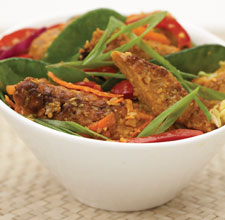The benefits and uses of tempeh

A healthy and nutritious choice.
Tempeh (pronounced TEM-pay) originated 4,000 years ago in Indonesia and is still consumed daily by many Indonesians, usually with rice as part of the meal. Its firm texture, mild flavor and excellent nutrient profile make it an ideal stand-in for meat or fish in recipes.
Tempeh is a tender, chewy cake made from whole soybeans or a mixture of soybeans, grains and seeds. The soy is soaked, chopped, semi-cooked, mixed with a mold culture, then compressed on trays and left in a warm place to ferment for several hours.
Nutrition information
Tempeh is high in protein and fiber, low in fat and has no cholesterol. It’s a fair source of calcium and a good source of B-vitamins, except vitamin B12, a nutrient available only from animal sources.
Dieticians consider tempeh to be the most beneficial source of protective nutrients in soy, such as isoflavones and genestein, because it’s a whole food and all its fiber is totally digestible, effectively delivering all nutrients.
Buying and storing tempeh
Tempeh is sold in PCC’s refrigerated case in a variety of flavors. As with other aged or fermented products (such as cheese), a little black on the surface of tempeh is normal. Dark spots are just the natural “blooming” of the culture. The more black spots, the stronger and sharper the flavor. Select lighter-colored tempeh for a milder taste and darker varieties for a stronger flavor.
Refrigerated tempeh should be used or frozen by its “best used by” date. Frozen tempeh keeps well for several months and it’s texture is not altered.
How to use tempeh
Tempeh often is considered the “meatiest” of soy foods and the most versatile for cooking. It keeps its shape well and easily takes on flavors of marinades or companion ingredients. It can be fried, baked or barbecued as burgers, in a loaf, or skewered as kabobs. All tempeh should be cooked thoroughly for at least 20 minutes to ensure digestibility.
Tempeh is a good way to introduce soy nutrients to people who enjoy meat. Try using half tempeh, half ground meat for burgers or pasta sauces. This keeps a meaty flavor but gains the benefits of soy, including fiber.
Grilling
Tempeh is delicious from the grill. Marinate tempeh for 20 minutes at room temperature or several hours in the refrigerator. Cut either into 1/2-inch slabs or skewer one-inch cubes with mushrooms, bell peppers, cherry tomatoes, zucchini and onions.
Sandwiches
Thinly slice plain tempeh. Brown each side for 4 to 5 minutes in a little oil over low or medium heat, sprinkling with soy sauce or a favorite marinade. Serve as a burger on a bun with your favorite traditional condiments.
For a “Reuben” sandwich, serve sautéed tempeh on rye bread and top one side with sauerkraut and a slice of Swiss cheese. Broil briefly to melt cheese and serve with spicy mustard and/or horseradish and crisp spinach leaves.
Salads
Marinate cubes of tempeh then lightly sauté in a little oil. When cool, add to salad combinations that call for diced ham or chicken. For a “tuna salad,” steam plain tempeh for 20 minutes, then dice small or mash and add minced celery, mayonnaise, red or green onion, and a bit of dill or sweet pickle relish.
Stir-fry dishes
Cut unseasoned tempeh into 1-inch cubes and marinate for 20 minutes at room temperature in 1 cup water and 1/3 cup soy sauce or your favorite marinade. Sauté in a little oil for 10 to 15 minutes on medium-low heat, then remove.
Add more oil and 2 to 3 cups of vegetables. When vegetables are nearly cooked, add tempeh with an optional handful of bean sprouts and stir-fry for another few minutes. Use leftover marinade as liquid to season during cooking.
Did you know?
Eighty-five percent of the United States’ soybean crop is genetically engineered.
To avoid genetically engineered ingredients, choose tempeh made from certified organic soybeans.
Organic standards prohibit genetically engineered ingredients.
